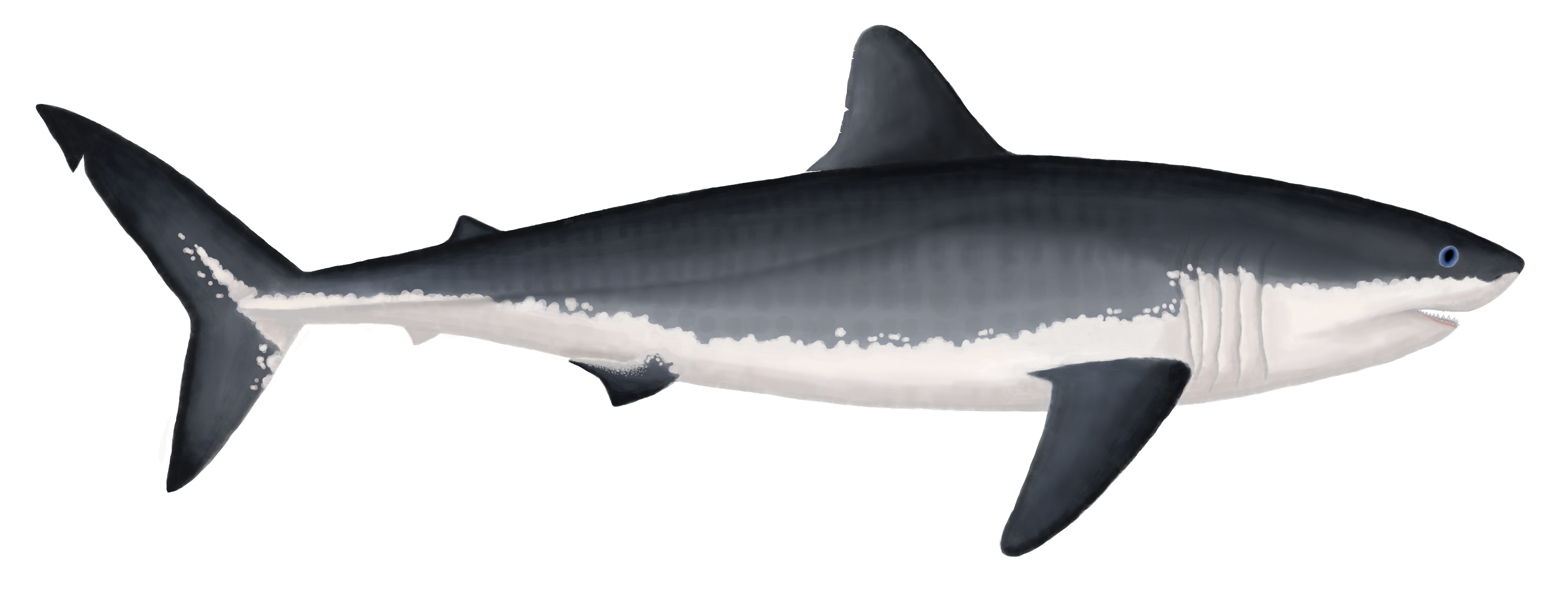Post by dinosauria101 on Sept 24, 2019 16:05:02 GMT 5
Cretoxyrhina mantelli
Cretoxyrhina (/ˌkrˈɪtɔːksiːrhaɪnə/; meaning 'Cretaceous sharp-nose') is an extinct genus of large mackerel shark that lived about 107 to 73 million years ago during the late Albian to late Campanian of the Late Cretaceous period. The type species, C. mantelli, is more commonly referred to as the Ginsu shark, first popularized in reference to the Ginsu knife, as its theoretical feeding mechanism is often compared with the "slicing and dicing" when one uses the knife. Cretoxyrhina is traditionally classified as the likely sole member of the family Cretoxyrhinidae but other taxonomic placements have been proposed, such as within the Alopiidae and Lamnidae.
Measuring up to 8 meters (26 ft) in length and weighing up to 3,400 kilograms (3.3 long tons; 3.7 short tons), Cretoxyrhina was one of the largest sharks of its time. Having a similar appearance and build to the modern great white shark, it was an apex predator in its ecosystem and preyed on a large variety of marine animals including mosasaurs and plesiosaurs, sharks and other large fish, pterosaurs, and occasionally dinosaurs. Its teeth, up to 8 centimeters (3 in) in height, were razor-like and had thick enamel built for stabbing and slicing prey. Cretoxyrhina was also among the fastest-swimming sharks, being capable of pursuing prey with burst speeds of up to 70 kilometers per hour (43 mph). It has been speculated that Cretoxyrhina hunted by lunging at its prey at high speeds to inflict powerful blows, similar to the great white shark today, and relied on strong eyesight to do so.

upload.wikimedia.org/wikipedia/commons/3/35/Ginsu_shark_%28Cretoxyrhina_mantellii%29.jpg
Xiphactinus audax
Xiphactinus (from Latin and Greek for "sword-ray") is an extinct genus of large (4.5 to 6 metres (15 to 20 ft)) predatory marine bony fish that lived during the Late Cretaceous (Albian to Maastrichtian).[3] When alive, the fish would have resembled a gargantuan, fanged tarpon (to which it was, however, not related).[4] The species Portheus molossus described by Cope[4] is a junior synonym of X. audax. Skeletal remains of Xiphactinus have come from the Carlile Shale and Greenhorn Limestone of Kansas (where the first Xiphactinus fossil was discovered during the 1850s in the Niobrara Chalk),[1][5] and Cretaceous formations all over the East Coast (most notably Georgia, Alabama, North Carolina, and New Jersey) in the United States,[1] as well as Europe, Australia[6], the Kanguk and Ashville Formations of Canada,[1] and La Luna Formation of Venezuela.
:max_bytes(150000):strip_icc()/xiphactinusDB-56a2574f5f9b58b7d0c92dc1.jpg)
www.thoughtco.com/thmb/HUMHMl4tx62usixvqQZ_NRsgoys=/768x0/filters:no_upscale():max_bytes(150000):strip_icc()/xiphactinusDB-56a2574f5f9b58b7d0c92dc1.jpg
Credit to Wikipedia
Cretoxyrhina (/ˌkrˈɪtɔːksiːrhaɪnə/; meaning 'Cretaceous sharp-nose') is an extinct genus of large mackerel shark that lived about 107 to 73 million years ago during the late Albian to late Campanian of the Late Cretaceous period. The type species, C. mantelli, is more commonly referred to as the Ginsu shark, first popularized in reference to the Ginsu knife, as its theoretical feeding mechanism is often compared with the "slicing and dicing" when one uses the knife. Cretoxyrhina is traditionally classified as the likely sole member of the family Cretoxyrhinidae but other taxonomic placements have been proposed, such as within the Alopiidae and Lamnidae.
Measuring up to 8 meters (26 ft) in length and weighing up to 3,400 kilograms (3.3 long tons; 3.7 short tons), Cretoxyrhina was one of the largest sharks of its time. Having a similar appearance and build to the modern great white shark, it was an apex predator in its ecosystem and preyed on a large variety of marine animals including mosasaurs and plesiosaurs, sharks and other large fish, pterosaurs, and occasionally dinosaurs. Its teeth, up to 8 centimeters (3 in) in height, were razor-like and had thick enamel built for stabbing and slicing prey. Cretoxyrhina was also among the fastest-swimming sharks, being capable of pursuing prey with burst speeds of up to 70 kilometers per hour (43 mph). It has been speculated that Cretoxyrhina hunted by lunging at its prey at high speeds to inflict powerful blows, similar to the great white shark today, and relied on strong eyesight to do so.

upload.wikimedia.org/wikipedia/commons/3/35/Ginsu_shark_%28Cretoxyrhina_mantellii%29.jpg
Xiphactinus audax
Xiphactinus (from Latin and Greek for "sword-ray") is an extinct genus of large (4.5 to 6 metres (15 to 20 ft)) predatory marine bony fish that lived during the Late Cretaceous (Albian to Maastrichtian).[3] When alive, the fish would have resembled a gargantuan, fanged tarpon (to which it was, however, not related).[4] The species Portheus molossus described by Cope[4] is a junior synonym of X. audax. Skeletal remains of Xiphactinus have come from the Carlile Shale and Greenhorn Limestone of Kansas (where the first Xiphactinus fossil was discovered during the 1850s in the Niobrara Chalk),[1][5] and Cretaceous formations all over the East Coast (most notably Georgia, Alabama, North Carolina, and New Jersey) in the United States,[1] as well as Europe, Australia[6], the Kanguk and Ashville Formations of Canada,[1] and La Luna Formation of Venezuela.
:max_bytes(150000):strip_icc()/xiphactinusDB-56a2574f5f9b58b7d0c92dc1.jpg)
www.thoughtco.com/thmb/HUMHMl4tx62usixvqQZ_NRsgoys=/768x0/filters:no_upscale():max_bytes(150000):strip_icc()/xiphactinusDB-56a2574f5f9b58b7d0c92dc1.jpg
Credit to Wikipedia


